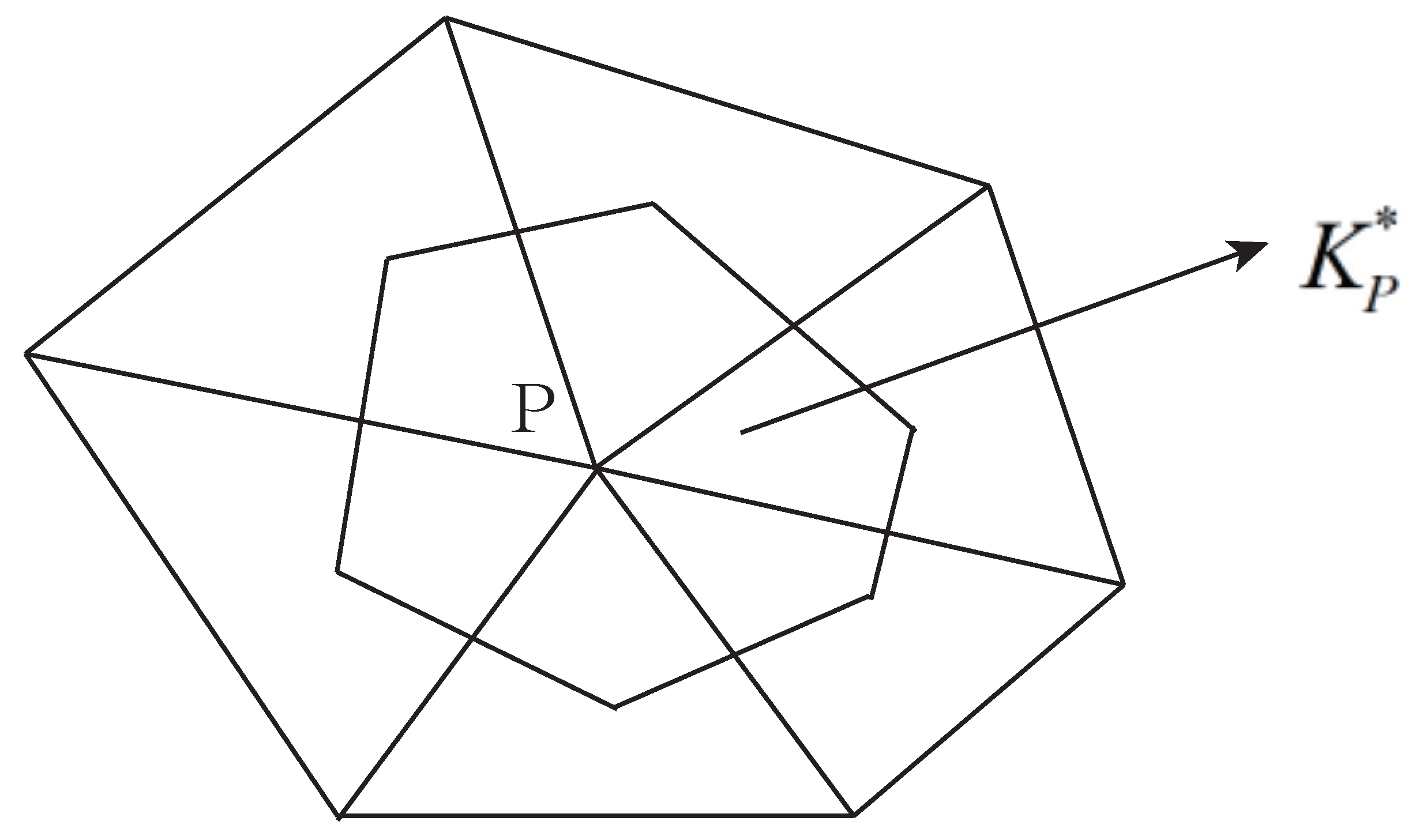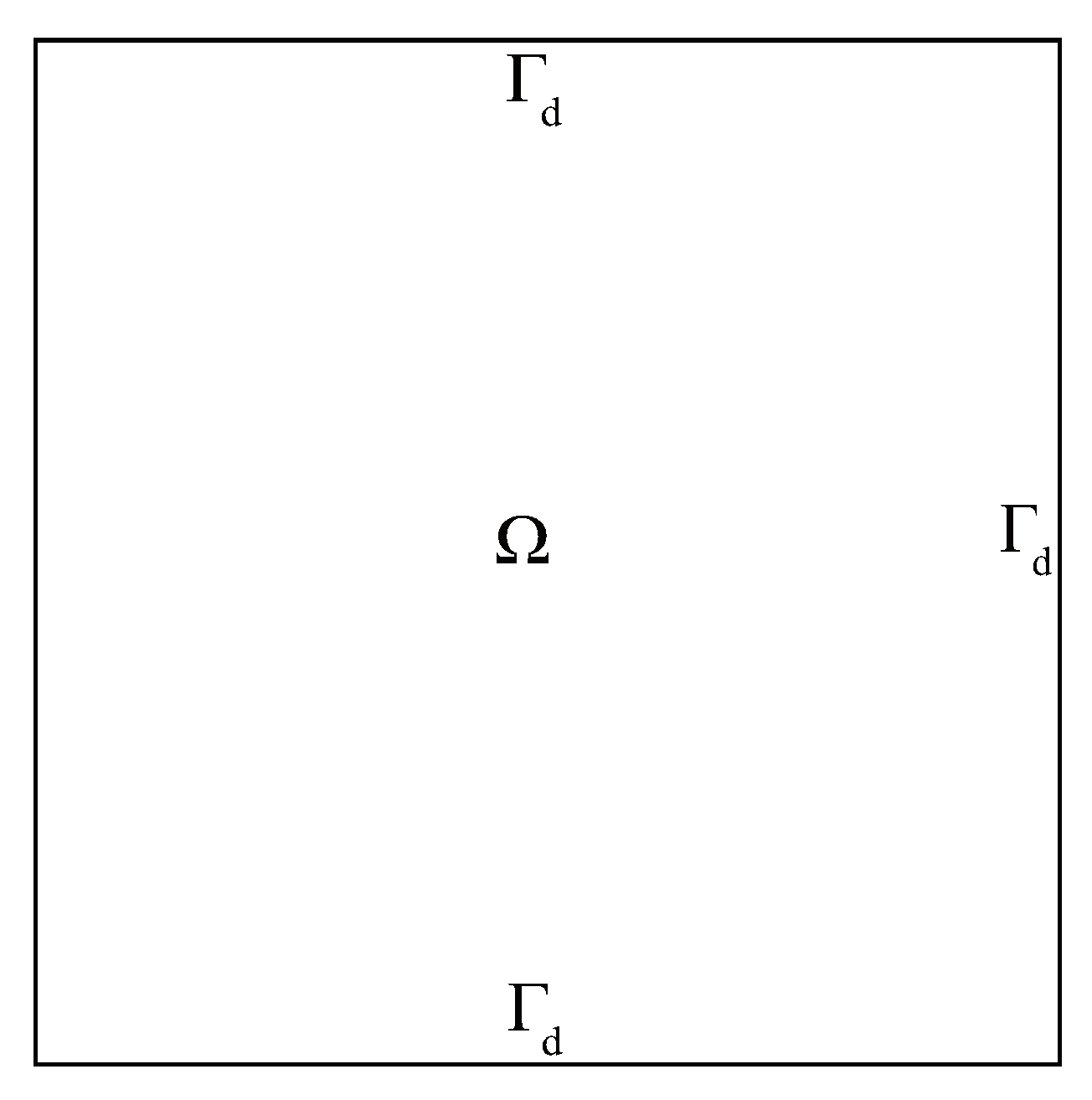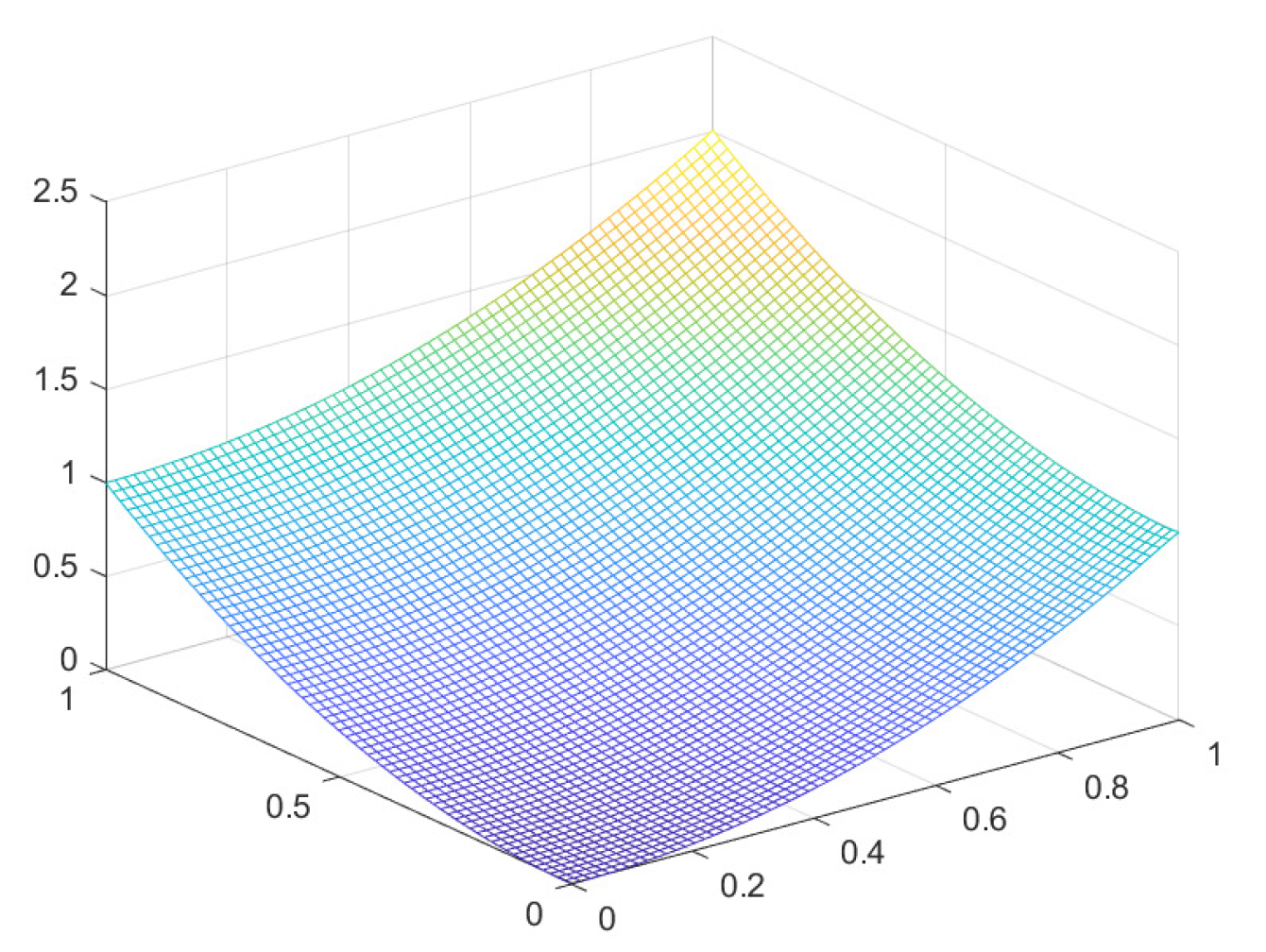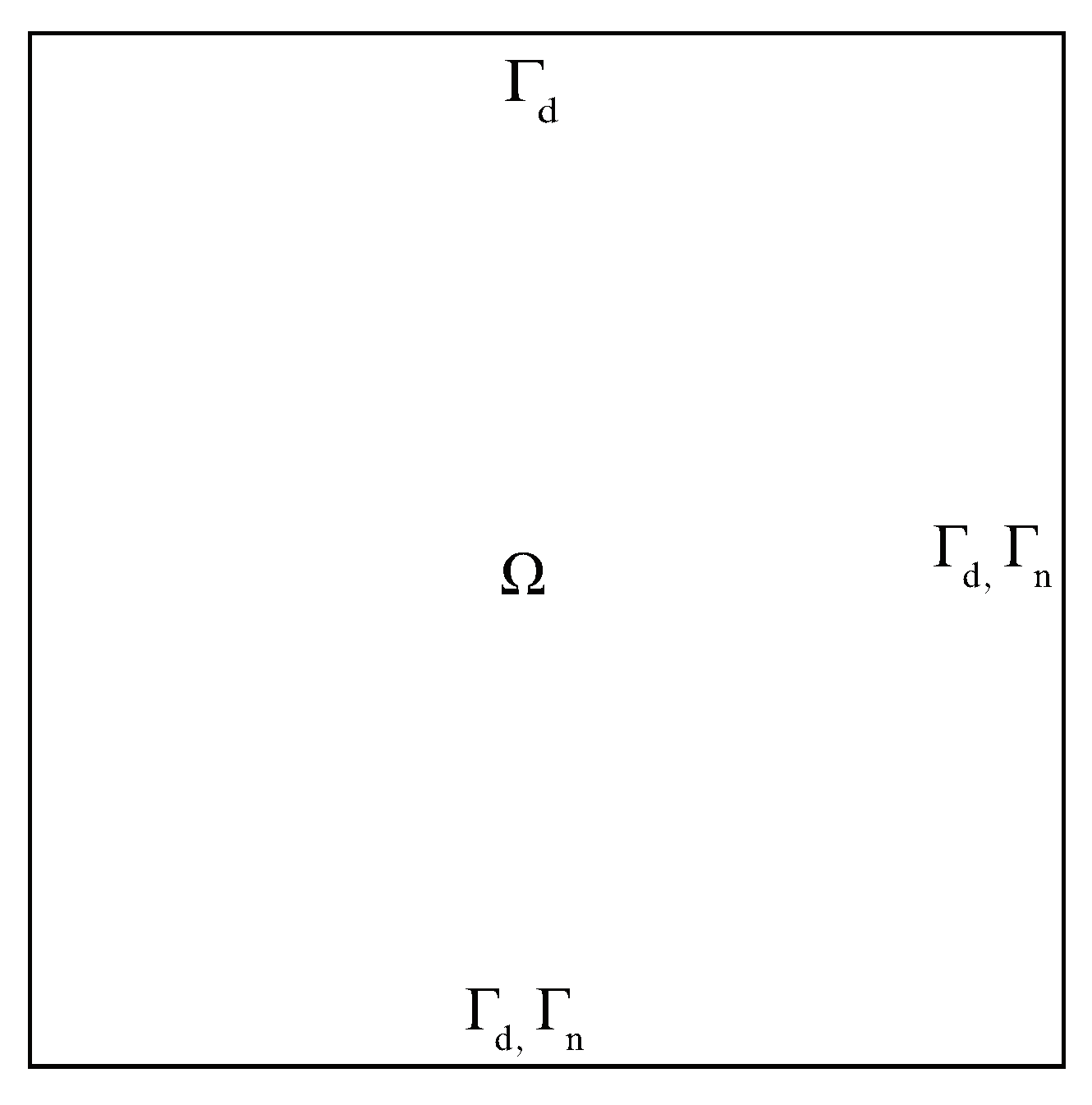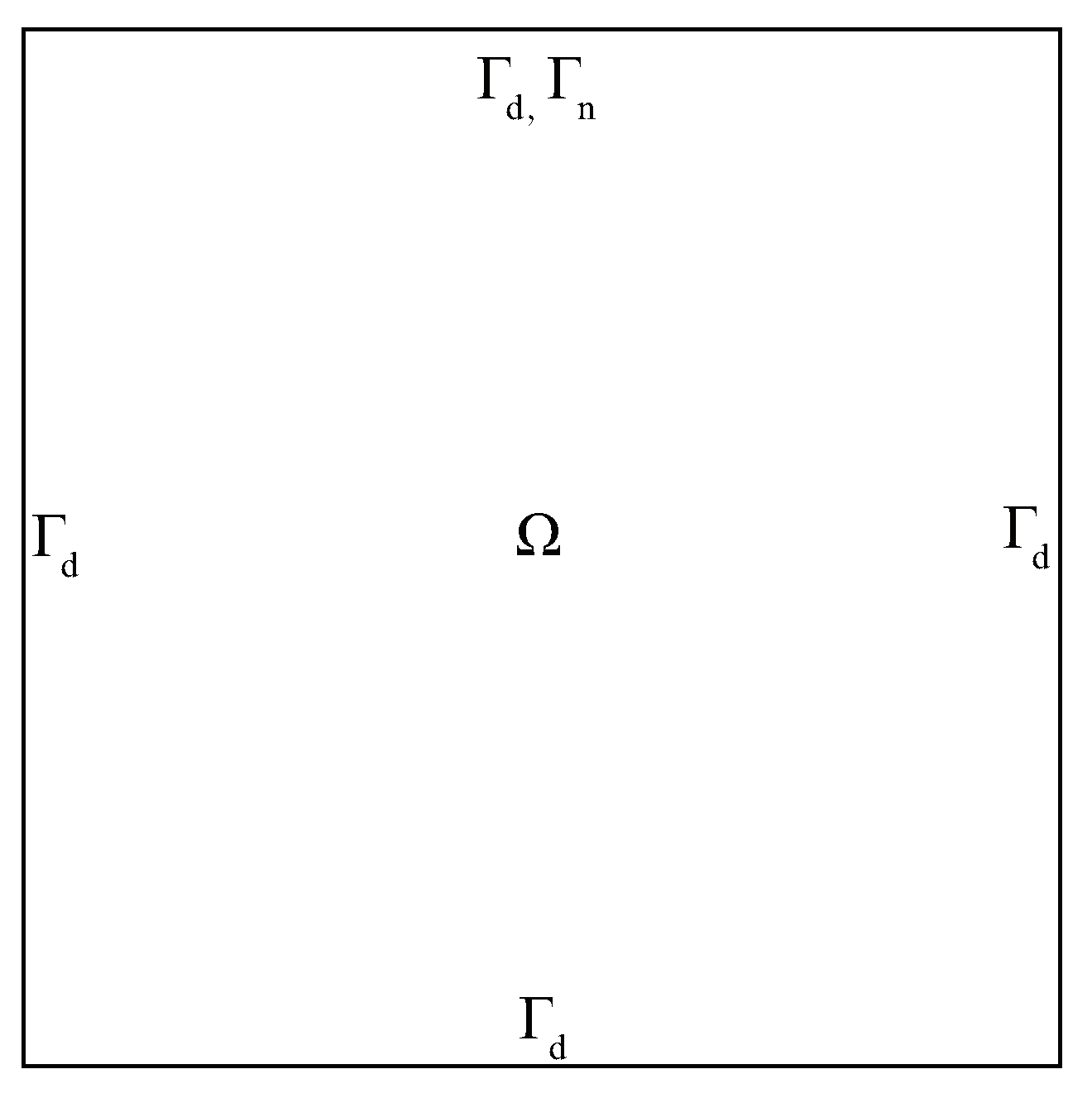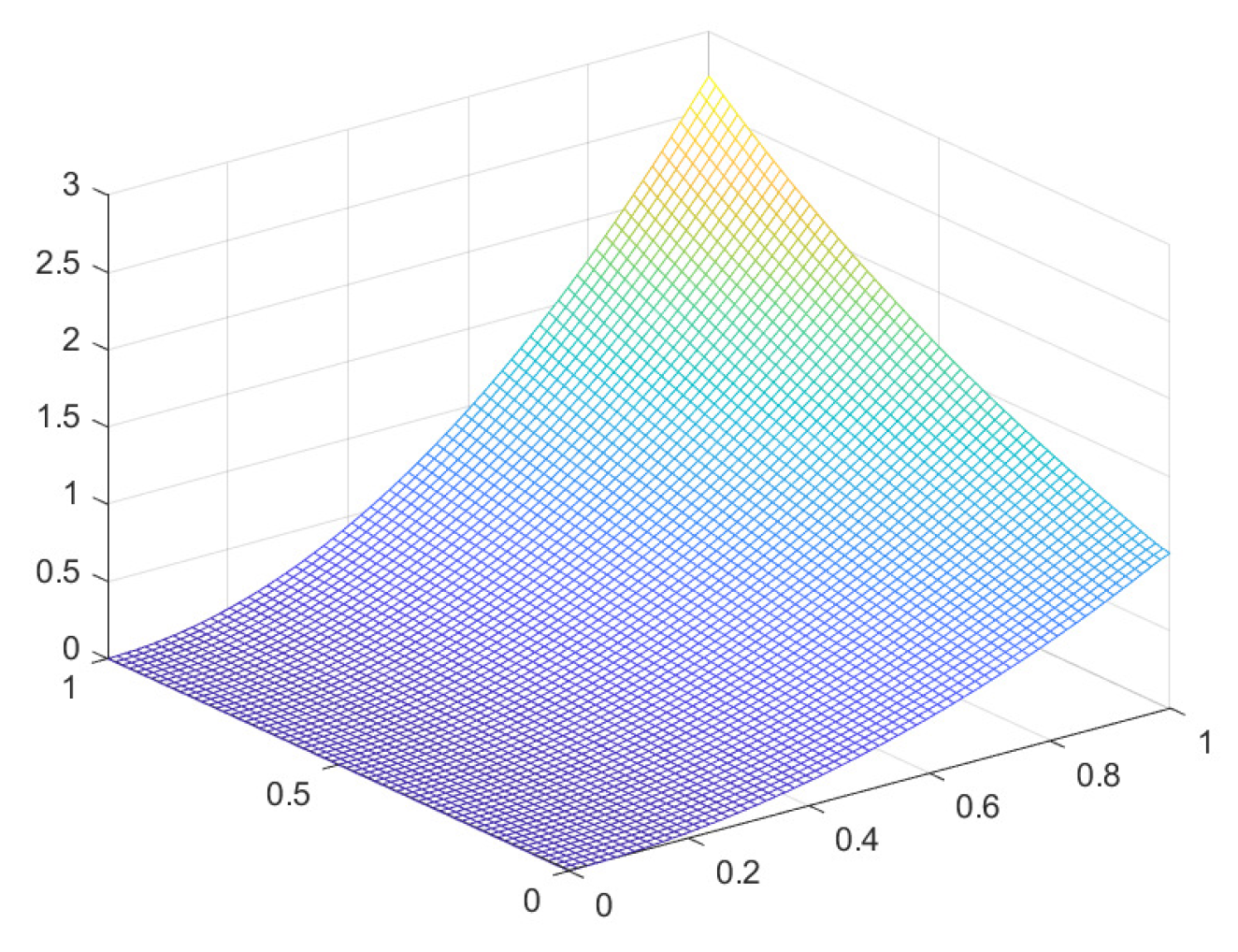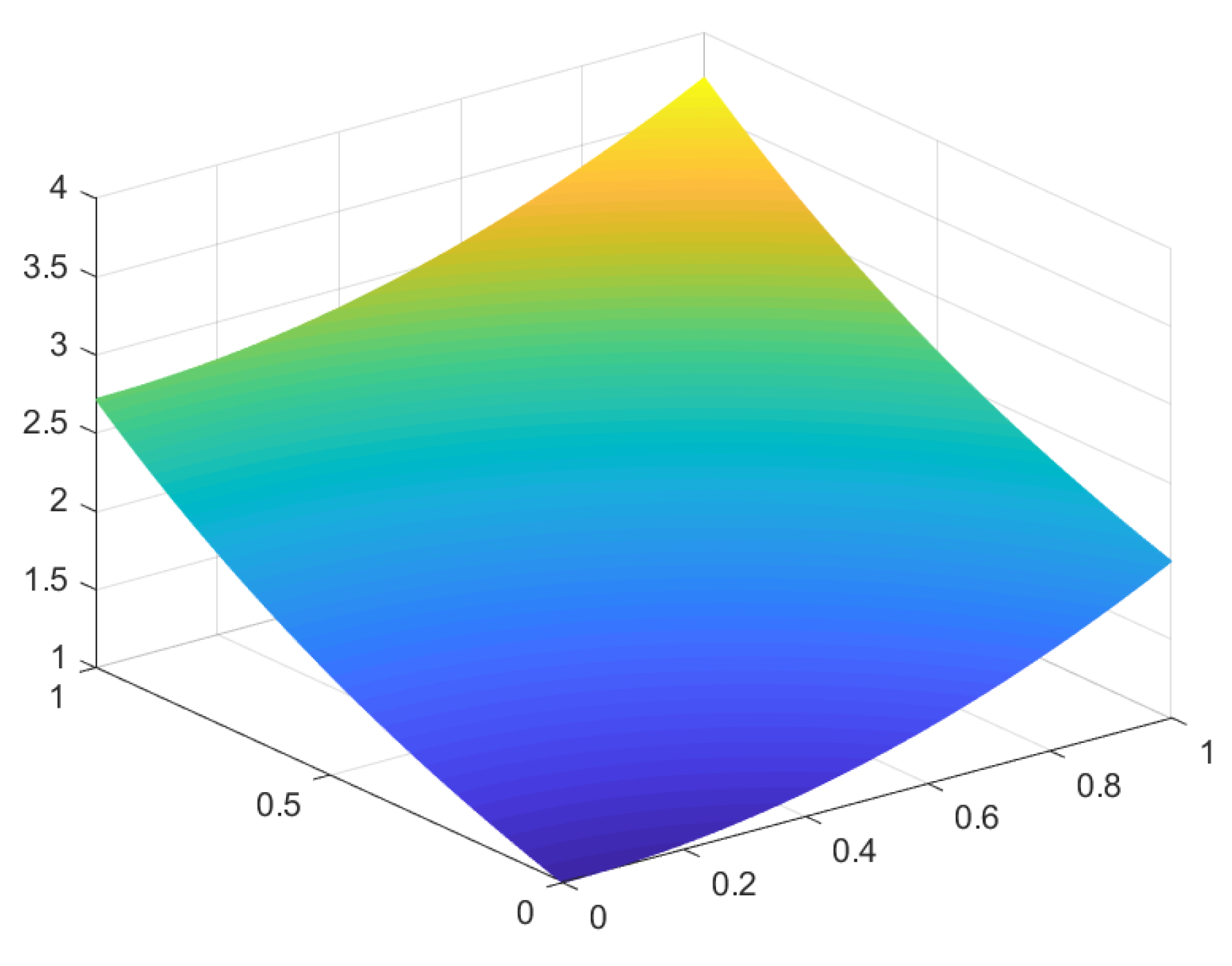1. Introduction
In this present paper, we consider the finite volume element method for solving the following second-order ill-posed elliptic problem
where
is a bounded polygonal domain in
with boundary
,
and
are two parts of the boundary
and
,
n is the unit external normal vector on
,
,
and
are known real-valued functions,
is assumed to be such that
. When
or
, elliptic problem (
1) is called ill-posed, caused by the ill-posed boundary conditions. For example, in some engineering projects such as the dam with underground boundary, the ultra-high temperature surface of the spaceships, in these cases, part boundary conditions cannot be measured. This kind of ill-posed elliptic problem is to resolve a problem with lacking boundary conditions on part of the domain boundary [
1].
Ill-posed elliptic problems have attracted many researchers since the 1960s due to their wide applications such as geophysics, steady-state inverse heat conduction, wave propagation, cardiology, electromagnetic scattering enzymatic reactions, bifurcation phenomena, phenomena in chemistry and plasma physics, and so on [
2,
3,
4]. In 1902, Hadamard [
5] first introduced the concept of the well-posed Cauchy problem, and later in 1923, he published the well-known example in [
6] at Yale University. He illustrated the ill-posedness of the Cauchy problem for the Laplace equation (
and
in problem (
1)). The work of Hadamard laid the foundation of the theory for the ill-posed Cauchy problems of elliptic equations. From then on, the theory has been further developed.
For severely ill-posed problems, the common numerical methods may not achieve optimal error estimates without some proper strategies. In [
7], a stabilized finite element method was proposed in which a primal and an adjoint problem were solved simultaneously. Yagola et al. [
8] discussed regularizing algorithms using a priori information. Klibanov [
9] discussed a universal method of the regularization for ill-posed Cauchy problems by constructing Tikhonov functionals. Chung et al. [
10] proposed a least squares formulation for the ill-posed problems and Qian [
11] proposed a wavelet dual least squares method for the ill-posed elliptic problems. Cheng et al. [
12] developed a numerical method for the ill-posed Cauchy problem of the Laplace equation where the essence of the method is to transform the Cauchy problem into a moment problem whose numerical method has been studied extensively. We refer the readers to [
13,
14,
15,
16] for more details on how to handle the severely ill-posed problems numerically.
Burman has conducted a series of research about ill-posed elliptic problems. In 2013, he proposed a stabilized finite element method to solve nonsymmetric indefinite problems [
7] where the main idea is to solve a primal and an adjoint problem simultaneously. In 2014 [
17], he further developed the analysis for the stabilized finite element method proposed in [
7] where the weak continuous dependence was assumed so that the error estimate can be derived. In 2018, Burman et al. [
18] showed that the stabilization methods for solving the ill-posed convection-dominated convection-diffusion problems are better than that of the Tikhonov regularization method. Wang et al. [
2,
19] devised a well-posed numerical scheme for a type of ill-posed elliptic problem by using a new primal-dual weak Galerkin finite element method where weak gradients were used in [
19] while weak Laplacian was used in [
2]. However, in their methods, the well-posedness of the discrete scheme was based on the uniqueness of the exact solution of the ill-posed problem and the error estimates were given only in some semi-norms. To the authors’ best knowledge, there is no research on the finite volume element method (FVE) for solving the ill-posed elliptic problem. The advantage of the FVE method [
20,
21,
22,
23,
24,
25] over some other numerical methods is that it can preserve some conservation properties of the original problem locally which are essential in some practical applications. Motivated by the work of Burman [
7,
17,
18] and Wang [
2,
19], this paper aims to propose a finite volume element method for solving the ill-posed elliptic problem (
1). The main difficulty of this problem is that the bilinear form of the variational equation derived from the ill-posed elliptic problem contains an individual boundary integral term because of lacking or overlap boundary conditions, so it is not positive definite on the solution space. Therefore, based on this bilinear form, the well-posedness of the discrete solution cannot be assured and it is very difficult to derive the error estimates in the
and
norms. To overcome this difficulty, the key technique in our paper is to introduce the primal-dual finite volume scheme and add proper stability terms on
and
. Compared with the research works of Burman [
7,
17,
18] and Wang [
2,
19], the advantage of our method is that our stability analysis and error estimates do not depend on some additional assumptions on the ill-posed problem. Our discrete scheme admits a unique solution and can achieve the optimal convergence order in some proper norms, including the
-norm.
According to the research in [
1,
26] we know that the ill-posed elliptic problem (
1) has a solution
when boundary data
belong to a dense subset of
. If the solution exists, it must be unique when
is a nontrivial portion of the domain boundary. In this paper, we assume that the solution of the ill-posed elliptic problem (
1) exists and possesses a certain smoothness needed for our analysis.
Throughout this paper, we use the notations to indicate the standard Sobolev spaces on domain equipped with the norm and seminorm . When , we denote and , and we omit subscript D if . We also denote the letter C as a positive constant independent of the mesh size h.
This paper is organized as follows. We first establish a primal-dual finite volume scheme and prove the well-posedness of the discrete scheme in
Section 2. In
Section 3, we do the error analysis of the primal-dual finite volume scheme.
Section 4 is devoted to the numerical experiments to illustrate the theoretical analysis.
2. Finite Volume Element Formulation
Let
be a quasi-regular triangulation of
where
,
is the diameter of element
K. We assume that the triangulation is such that the endpoints of
and
are the nodal points of
. Denote
the set of all nodal points of
,
the set of all edges of
and
. With the triangulation
, we construct a barycenter dual partition
by connecting the midpoints of the three edges to the barycenter of each element
by straight lines. So, for each point
, there is a polygonal element
which is the dual element or the control volume of point
P, see
Figure 1. Let
and
be the trail function space and the test function space, respectively,
where
is the set of all
k-th order polynomials on
K.
For function
, define the interpolation operator
by
where
is the characteristic function of the dual element
. Thus,
It can be proved that is a one to one mapping from to , that is, .
For smooth function
, we can obtain from the Green formula that
Consequently, when
is the solution of problem (
1),
u satisfies the variational equation
where
and
In view of the ill boundary condition in general, the variational form (
7) is not well-posed. In order to define a well-posed discrete scheme, we first introduce the jump
of function
u across element edge
e by
where
e is the common edge of elements
and
,
are the unit external normal vectors to
and
, respectively. Furthermore, for vector function
w,
For any
, denote
where
.
From Equation (
7), we see that when the solution of problem (
1)
,
u and the Lagrange multiplier
satisfies the following primal-dual variation equations with stabilizers
Based on the weak form (
15), we define the primal-dual finite volume element approximation of problem (
1): find
such that
Obviously, the discrete scheme (
16) is consistent.
Next, we recall some known results which will play an important role in our analysis. Let
be the standard linear interpolation operator. The approximation property of
, trace inequality and finite element inverse inequality are as follows
Lemma 1 ([
27]).
Let and be an edge of K. Then, for , the following results hold Lemma 2. Let . Then, for , the interpolation operator has the following approximation properties Proof. Let
P be a vertex of element
K. Denote
the one third part of element
K, then
on
. Following the inverse inequality, we can obtain
which gives estimation (
22). In order to prove (
23), we let
, by using trace inequality (
18) and (
22) we have
which completes the proof. □
The basic idea of our forthcoming analysis is to regard the FVE method as a disturbance of the FEM [
24,
27,
28], so we need to give the relationship between the bilinear form of FVE and that of FEM.
Define the bilinear form of FVE and FEM, respectively,
Lemma 3 ([
27]).
Let the algebraic sum space . For all , we have From Lemma 3, we can obtain the following estimate between the bilinear form of FVE and that of FEM.
Lemma 4. For all , we have Proof. From Lemma 3, Lemma 1, Lemma 2 and noting that
is a piecewise linear function on
, we can derive
where
is the mean of
on element
K. The proof is completed. □
From Lemma 4 and
, we see that when
h is sufficiently small, the following inequality holds
By the definitions of
and
, we have
Lemma 5. For sufficiently small h, we havewhere is a constant. Proof. By using Lemma 1, Lemma 2 and the inverse inequality, we obtain
We complete the proof by combining (
31) and (
32). □
Theorem 1. Assume that either or is not a straight line, then the solution of finite volume element scheme (16) exists uniquely. Proof. We just need to prove that the discrete linear homogeneous equations (
16) only have the trivial solutions. Let
in (
16) and take
, we can derive by adding the two equations
With the definitions of
and
, we obtain
Notice that
is piecewise constant on
, then by
we know that
is a constant on the whole domain
and
is a single linear polynomial on
. Thus, by
,
and the condition of Theorem 1, we can assert that
on
. Furthermore, from the first homogeneous Equation in (
16) we can obtain
Taking
in (
37), using Lemma 5 and
we can deduce
, that is,
is a constant. Furthermore,
implies that
on
. □
Theorem 1 gives the well-posedness of the primal-dual finite volume element scheme (
16).
4. Numerical Experiment
In this section, we provide two numerical examples to illustrate the effectiveness of the proposed primal-dual finite volume element method (
16). In the numerical experiment, all computations are carried out by using Matlab R2019a.
We consider problem (
1) on the domain
with
. The source term
is determined by the exact solution
with the formula
. The boundary data
on
and
on
depends on the given exact solution
.
In the numerical examples, we first partition the domain into the squares with mesh size . Then, each square is divided into two triangles by the diagonal line connection which results in a uniform triangulation whose mesh size is . Based on the uniform triangulation, we construct the barycenter dual partition by connecting the midpoints of the three edges to the barycenter of each element in with straight lines.
The error estimation of the primal-dual finite volume element solution is computed in the following three norms
Example 1. In this experiment, the exact solution is . We consider three boundary conditions as follows
B.C. I: Lacking boundary condition (See
Figure 2.)
B.C. II: Lacking and overlap boundary condition (See
Figure 3.)
B.C. III: Overlap boundary condition (See
Figure 4.)
The errors and convergence rates of the numerical solution for the above three kinds of boundary conditions are shown in
Table 1,
Table 2 and
Table 3, respectively.
The exact solution
u and the numerical solution
of B.C. I are shown in
Figure 5 and
Figure 6, respectively.
Example 2. In this experiment, the exact solution is . We consider three boundary conditions as follows
B.C. I: Lacking boundary condition (See
Figure 2).
B.C. IV: Lacking and overlap boundary condition (See
Figure 7).
B.C. V: Overlap boundary condition (See
Figure 8).
The errors and convergence rates of the numerical solution for the above three kinds of boundary conditions are shown in
Table 4,
Table 5 and
Table 6, respectively.
The exact solution
u and the numerical solution
of B.C. V. are shown in
Figure 9 and
Figure 10, respectively.
Example 3. In this experiment, the exact solution is . We consider three boundary conditions as follows:
B.C. I: Lacking boundary condition (See
Figure 2).
B.C. II: Lacking and overlap boundary condition (See
Figure 3).
B.C. V: Overlap boundary condition (See
Figure 8).
The errors and convergence rates of the numerical solution for the above three kinds of boundary conditions are shown in
Table 7,
Table 8 and
Table 9, respectively.
The exact solution
u and the numerical solution
of B.C. V are shown in
Figure 11 and
Figure 12, respectively.
